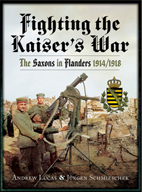All of the following photos were taken by my mother Ann Lucas at the Memorial Museum Passchendaele 1917 in Zonnebeke on 25th-26th April 2015. For this special occasion I was uniformed as a gefreiter of 2. Battr. / Reserve-Feldartillerie-Regiment Nr.54, part of the Saxon element of the mixed 54. Reserve-Division / XXVII. Reserve-Korps. The division's Württemberg element was well represented by our comrades from Reserve-Infanterie-Regiment Nr.248 (part of the Darstellungsgruppe Süddeutsches Militär 1870-1918 e.v.).
Below: talking to the public about the experiences of the Saxon and Württemberg troops in the Zonnebeke area a century ago. Note our comrades from RIR 248 and my old chum Michael from the 1914-21 Society (in his new Ottoman uniform).


Right: the authors take a brief rest between visitors.
Note the so-called Riechpäckchen on my shoulder (as issued for the first gas attacks in April-May 1915) and the enlisted man's shoulderstraps with metal numerals, a peculiarity seen in original photos from many of the war-raised Saxon field artillery units formed in 1914-1915.
Both pieces of kit were made for me by the very talented Herr Bernd Fehrle of Bekleidungsamt XIII. Currently my Riechpäckchen only has a dummy filling, but I do intend to replicate the crude cotton wool and gauze pad impregnated with chemicals which was carried inside (to be tied over the face before the chlorine cylinders were opened).
Below: The Herr Feldwebel puts the men of Der Alte Armee through their paces. Sadly I didn't manage to chat with Mario and his lads (whom I hadn't seen in years) as much as I would have liked, but will certainly make up for it next time we meet!

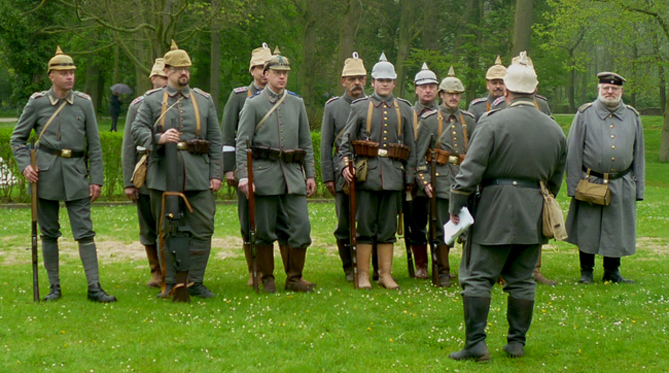
Below: I was still awaiting the issue of my new shoulderstraps at this point. Beside me are (I think) a sergeant of Badisches Leib-Grenadier-Regt. Nr.109 and a musketier of Landwehr-Infanterie-Regiment Nr.65. I'm not sure about the seated chap - probably Füsilier-Regt. von Steinmetz (1.Westpreußisches) Nr.37? Note the little dog in the background, who kept us amused all weekend!


Right: Anna, Patrick and I representing Germany in the narrated living history presentation. Our infantry had worked out that this would involve standing uncomfortably still for an extended period, hence only the artillery, cavalry and medical services were represented! Just visible behind us are the Belgian contingent and a lone New Zealander.
I had never previously seen Patrick's 'new' impression as a ulan of Ulanen-Regt. Hennigs von Treffenfeld (Altmärkisches) Nr.16 and was suitably impressed. Not only is his kit flawlessly accurate, but he also has the stature and bearing to carry off elegant cavalry uniforms. I only regret that I couldn't persuade him to pick a Saxon regiment! I look forward impatiently to seeing the completed impression together with horse and tack at future events.
Note that the riding boots (Reitstiefel) and reinforced riding breeches (Reithose) Patrick is wearing would also be correct for drivers and NCOs of the artillery - something I may consider in future if I'm feeling wealthy enough for such a major kit upgrade! At least for 1914-1915 a sabre would also be necessary... and inevitably of course, the Saxon enlisted men's artillery sabre is significantly different from its Prussian equivalent.
Below: British (more specifically, Scottish) gas drill with the 'Hypo helmet' and the 'PH hood' (AKA 'the goggle-eyed booger with the tit') which replaced it. I believe these gentlemen were actually Belgians, but do not know the name of the group. The yet more basic gas protection of May 1915 was also demonstrated at one point - I think by our friends from The Rifles.
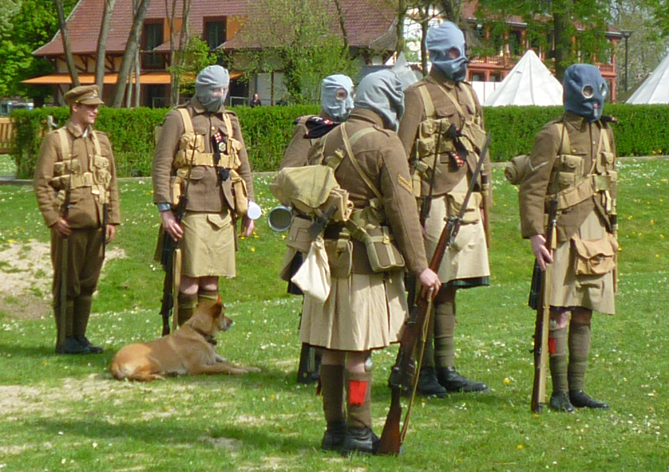
Below: personnel from RIR 248, LIR 65 and bayerisches Reserve-Infanterie-Regiment Nr.20 (with the Landsturm-pattern Wachstuchmütze famously worn by several regiments of 6. bayerische Reserve-Division in Flanders in 1914) demonstrate how to bind a broken arm in the field with two bayonets.


Below: comrades from various units of the DSM 1870-1918 relaxing in their encampment. Note the marvellous original Blinkgerät (signal lamp). The gentleman in puttees is a driver of the Württemberg Train, a really interesting and unusual impression which I had never expected to see!


Right: Jürgen signs yet another copy of Fighting the Kaiser's War for one of our friends, while I chunter on about my favourite subject!
This was a rare (but we hope, not a unique) opportunity to have the book signed by both of the authors, and one which none of our new readers passed up on. We emptied at least one pen before the weekend was over.
Jürgen and I were delighted by the universally enthusiastic reception for our magnum opus, and anxiously await the first reviews...
As you can see I could only bring a small display with me thanks to the big box of books. As usual the Saxon Kugelhelm and Rundblickfernrohr 16 (panoramic gunsight for the 7.7cm Feldkanone 16) attracted a great deal of interest. Hopefully one day we will be able to display the rest of the Feldkanone and its crew!
Below: scenes from the commemorative service on Sunday morning, which included suitable contemporary readings and songs in Flemish, German, English and French. Poignantly for us, the German poem read by Mario that referred to the Broodseinde crossroads and billets at Moorslede was evidently written by a Saxon infantryman of 53. Reserve-Division (most likely from RIR 241).



|
Below (left): Bruce in his impressive Ottoman kit; due to their army's precarious logistics, Turkish soldiers rarely remained so well equipped and neatly uniformed for long in the field. |
Below (right): our good friend Dr. Adrian-Silvan Ionescu, mastermind of Romanian reenactment in his general's uniform. Hopefully we will meet once again in Transylvania during the anniversary years. |
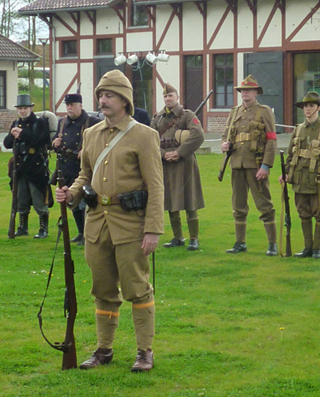 |
 |
Below: representatives of (I think) Korps-Fernsprechabteilung des XIII.AK, bRIR 20, RFAR 54 and Reserve-Infanterie-Regiment Nr.120, with the rebuilt church of Zonnebeke in the background. The quite large group of Württemberg Telegraphisten from the telephone unit put on a particularly impressive display, demonstrating the use of a lot of specialist equipment I had only seen before in period photos.

Below: the large contingent from the DSM 1870-1918 also included Bavarian Jägers from Kgl. Bayer. 1. Jäger-Bataillon König kitted out for mountain warfare on the Italian front. As regular readers may recall, this battalion spent Christmas 1914 attached to the Saxon XIX. Armeekorps near Warneton.
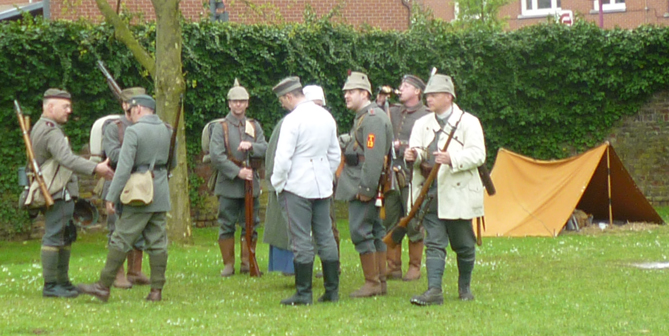
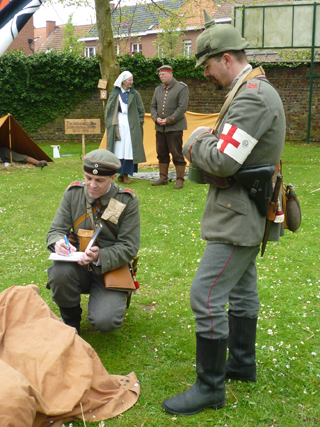
Right: it was a particular pleasure to sign copies of Fighting the Kaiser's War for several of our new 'comrades in arms'.
As Bernd and Manuel were delighted to discover, with no less than three 'mixed' divisions prominently featured in the book there is plenty in it to interest Württemberg specialists - and of course, plenty of ideas for further reenactment collaborations between the two contingents. Naturally, I would eagerly buy a similar book on the Württemberg (or indeed, Bavarian) army in Flanders if someone were to write it!
In summary this was a most enjoyable and rewarding event, and a welcome return to reenactment for me after an extended absence. Please keep an eye on this part of the website for further updates on my living history activities, and eventually tips and kit lists for anyone wishing to reenact a unit of the Royal Saxon army.
If you are interested in joining the 1914-21 Society's Saxon detachment or are already reenacting any Saxon unit (I know there are a few of you out there in Germany) please contact me and tell me all about it!
Providentiae Memor!

